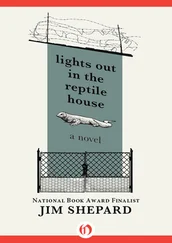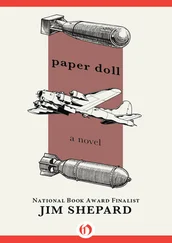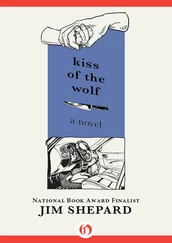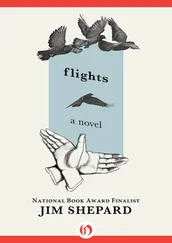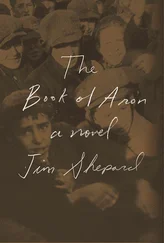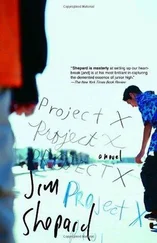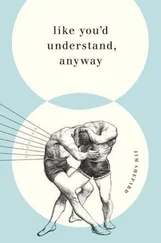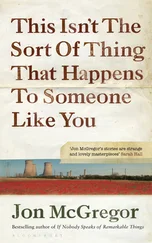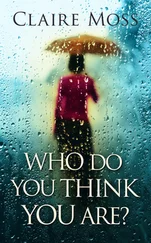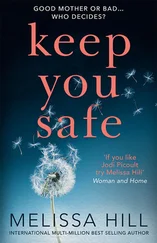We need to wake at one to get out of the tent by three. The wind is gone but we’re still shocked by the cold. Night and winter this high are like outer space. The other mountains below look like whitecaps on the ocean.
After so much time in the tent, it’s like learning to walk again. Jacek takes the lead on ice so hard our picks ring off it as if it were a bell. We pant in the insubstantial air. For eight hours we traverse pinnacles and chop through cornices. On the ice walls we get our feet secure with the front points of the crampons and then move the ice axes and reverse the process. Every few minutes we rest, leaning into the slope, heads on arms.
Then Jacek gives out a cry up ahead and I see that there’s nothing above him; he’s swung a leg over a summit crest so narrow that he has to straddle it like a horse. I climb up behind him and we pull ourselves forward with our hands, right legs dangling down the mountain’s north face and left legs the south. My boot punches through a cornice to provide a porthole view six thousand meters down. Jacek’s babbling something but I can’t make out what. I’m just relieved the wind is manageable.
Even at this time of day — is it noon? — the sky above is indigo, fading into a pink upper atmosphere.
We have to descend nearly immediately if we’re going to reach the tent before sunset. It takes some minutes to communicate that to Jacek by shaking his shoulder and shouting into his ear. We dismount the crest and belay one another downward as if negotiating a ladder, taking turns as anchors with our ice axes. If we start sliding in the shape we’re in, we won’t be able to stop. At some points the slope is so steep that we can’t see the wall below us from above. Spindrift burns our faces. A cloud mist leaves us in a half-light, like a waking dream. But an hour after darkness we manage to grope back into the tent and fall asleep instantly, one atop the other.
We wake to Bieniek’s alarm. His little boy is muffled under all of the layers. The boy repeats his good morning until we dig out his father’s wrist and turn him off.
We shake Bieniek and ask how he’s doing but he doesn’t answer. There are ice crystals in his hair. His nose and cheeks are brown. We ask more questions and he follows our movement with his eyes, though otherwise no longer seems present.
Once we’re sufficiently revived we make some tea with the last of the gas in the stove. There’s so little air in the tent that the flame is a small blue halo above the burner.
We shouldn’t start this late in the day, but we have to leave nonetheless. We assemble what bivouac gear we can for the likelihood that we’ll spend the night out in the snow. Jacek climbs from the tent as I put a farewell hand to Bieniek’s shoulder. His half of the tent is caved in. I touch a glove to his face and he doesn’t stir, but when I remove it he asks for water. While I pour him a cup, he says, “It’s quiet out. You could go down.” I ask if he can stand and he doesn’t answer. He no longer seems to be breathing. I lean in close, and listen, then set the cup on his chest and climb out myself.
Jacek leads on the way down. During a rest break in an ice gully he tells me to keep an eye on him, because he’s starting to hallucinate again.
The storm blows in while we descend. Every few feet I’m surprised to find I’m still moving. It’s impossible to belay each other in these conditions but the alternative is to sit down and die. On less steep stretches I’m frightened by momentary blackouts from which I emerge after apparently having proceeded five or six paces.
During another rest break Jacek informs me he can’t breathe properly and asks if his lips are blue. Our boots hang out into space off the ledge on which we’re sitting. The wind is such that it looks like we’re kicking with them.
I tell him not so blue. The process begun in the tents is accelerating with the strain of all this agonized work: his lungs are filling with fluid, drowning the alveoli that absorb the oxygen.
We keep plodding downward. Finally in the starlight I can feel how close we’ve come to the edge of a giant balcony and I force us to stop. We dig a shallow snow cave in a languid stupor and then spoon inside it, taking turns on the warmer side. Even only this much lower, the air feels richer and full of oxygen, a pleasure to breathe.
The storm gets worse. A dull thundering rolls down from the summit pyramid. One of Wanda’s gestures sticks in my memory and I worry it like a puzzle. As my way of rejecting the notion that no more messages will get through, and that home has become an imaginary thing, I compose what I’m going to say to Agnieszka by way of apology.
The morning after our first night together, she told me that her brother had died climbing. When she went through his things, his assets turned out to be his equipment, most of which was left on the mountain. He’d always told her not to worry about the trip they were discussing; the next trip was the one that was going to prove dangerous. She told me this on the living room floor, her legs still wrapped around me. She was weeping and I was inside her. I analogized the intimacy in electrical terms, thinking we formed a complete circuit. After she pulled away from our kiss she said she still didn’t accept that he was gone. That she’d told herself, toward the end of his memorial service, he still had five minutes to turn up.
We should have been talking about all of this. But there’d only ever been time to discuss what had happened since I was gone, and where I was going next.
The hand that was clutching Jacek to my chest seems to have disappeared. I hold the glove up to the darkness but the fingers refuse to move.
He asks for some water and then doesn’t drink what I pass him. He recites my name and then, some hours later, Krystyna’s, until we pass beyond words some time during the night. We doze and wake and the difference seems hard to parse. When my eyes refocus there’s a strange shimmer all around us, as if the light is coming off the surface of the snow itself.
Agnieszka! I want to tell her. The mountains have brought us together, as well. They’ve always been the authors of our development. They’ve allowed us to see what no other human beings have ever seen. They’ve siphoned away the warmth, down to our core and beyond, as payment. They’ve left you and our child the notion, never correct, that you were alone all along. They’ve ensured that we’ve progressed this far, and no farther, when constructing our connections to this wild and beautiful earth.
Most of the stories in this collection could not have existed, or would have existed in a much diminished form, without critically important contributions from the following sources: the Municipality of Rotterdam’s Waterplan 2 Rotterdam; the Royal Netherlands Embassy’s Pioneering Water; Deltapark Neeltje Jans’s The Delta Project: Preserving the Environment and Securing Zeeland Against Flooding; Rotterdam Climate Proof’s The Rotterdam Challenge on Water and Climate Adaptation; Leo Adriaanse and Tjeerd Blauw’s Towards New Deltas; the Netherlands Water Partnership’s Climate Changes and Dutch Water Management; Hans van der Horst’s Rotterdam Discovered; William Z. Shetter’s The Netherlands in Perspective; the Ministerie van Verkeer en Waterstaat’s Storm Surge Barrier on the Nieuwe Waterweg; Stadshavens Rotterdam’s 1600 Hectares: Creating on the Edge; Dutch Delta Solutions’ Made in Holland; the Dutch Research Program’s Knowledge for Climate 2008–2013; the Port of Rotterdam’s Maasvlakte 2: Space for the Future; Elizabeth Kolbert’s Field Notes from a Catastrophe: Man, Nature, and Climate Change; Jan de Hartog’s The Little Ark; Colin White and Laurie Boucke’s The Undutchables; Willem Elsschot’s Cheese; Jules Archer’s Jungle Fighters; Eric Bergerud’s Touched with Fire: The Land War in the South Pacific; John Ellis’s The Sharp End; George H. Johnston’s The Toughest Fighting in the World; James Jones’s The Thin Red Line; E. J. Kahn’s G.I. Jungle; Samuel Milner’s The War in the Pacific: Victory in Papua; Ian Morrison’s Our Japanese Foe; Peter Schrijvers’s The G.I. War Against Japan; Stephen R. Taafe’s MacArthur’s Jungle War; and the Historical Division of the War Department’s Papuan Campaign; Richard Ellis’s Sea Dragons; Eileen Powers’s Medieval People; Jules Michelet’s Satanism and Witchcraft; Reginald Hyatte’s Laughter for the Devil: The Trials of Gilles de Rais, Companion-in-arms to Joan of Arc (1440); Jean Benedetti’s Gilles de Rais; Marjorie Rowling’s Everyday Life in Medieval Times; Michel Foucault’s I, Pierre Rivière; Gareth J. Medway’s The Lure of the Sinister: The Unnatural History of Satanism; Frances Winwar’s The Saint and the Devil; Peter Handke’s A Sorrow Beyond Dreams; G. R. de Beer’s Early Travellers in the Alps; Edward Whymper’s Scrambles Amongst the Alps; Colin Fraser’s Avalanches and Snow Safety; Fergus Fleming’s Killing Dragons: The Conquest of the Alps; Ronald Clark’s The Early Alpine Guides; Nicholas and Nina Shoumatoff’s The Alps: Europe’s Mountain Heart; McKay Jenkins’s The White Death: Tragedy and Heroism in an Avalanche Zone; Betsy Armstrong and Knox Williams’s The Avalanche Book; Brian Greene’s Fabric of the Cosmos; Lisa Randall’s Warped Passages; Ben R. Rich and Leo Janos’s Skunk Works; Trevor Paglen’s I Could Tell You but Then You Would Have to Be Destroyed by Me; Philip Taubman’s Secret Empire: Eisenhower, the CIA, and the Hidden Story of America’s Space Espionage; Freya Stark’s The Valley of the Assassins, The Southern Gates of Arabia , and The Zodiac Arch; Lieutenant-Colonel P. M. Sykes’s A History of Persia; Marshall G. S. Hodgson’s The Order of the Assassins; Bernard Lewis’s The Assassins; Jane Fletcher Geniesse’s Passionate Nomad: The Life of Freya Stark; Calvin Trillin’s “At the Train Bridge”; the Marinette County Jail transcript of the interview with Scott J. Johnson; Kurt Diemberger’s Spirits of the Air and Summits and Secrets; Anatoli Boukreev’s Above the Clouds; Maria Coffey’s Where the Mountain Casts Its Shadow and Fragile Edge; Greg Child’s Thin Air: Encounters in the Himalayas; Mark Jenkins’s “Ice Warriors”; Noel Busch’s Two Minutes to Noon; Charles Davison’s The Japanese Earthquake of 1923; Frank Stewart and Leza Lowitz’s Silence to Light: Japan and the Shadows of War; August Ragone’s Eiji Tsuburaya: Master of Monsters; Thomas R. H. Havens’s Valley of Darkness; Masuo Kato’s The Lost War; William Tsutsui’s Godzilla on My Mind; Soetsu Yanagi’s The Unknown Craftsman; and the Fujiya Hotel’s We Japanese .
Читать дальше

